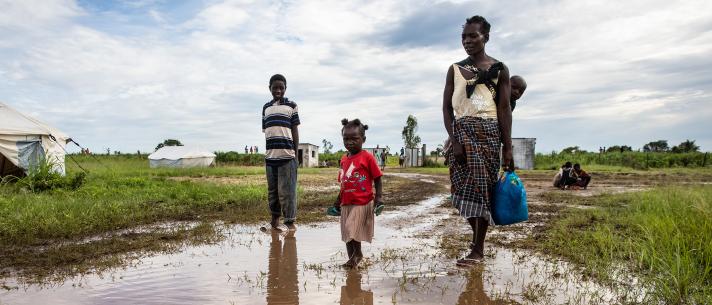Climate change is already affecting the frequency and intensity of extreme weather events (cyclones, heatwaves, droughts, floods, etc.), leading to degradation of ecosystems, disruption to food production and water supplies, damage to infrastructure and human establishments, morbidity and mortality.
In the last 2 decades, more than 80% of disasters have been linked to the climate. These extreme events have multiple severe consequences for the humanitarian needs of millions of people worldwide.
They condemn certain very vulnerable countries and communities that have already suffered shocks and occasional or chronic climate risks, as well as having underlying social and environmental problems, to constant and prolonged states of crisis, where emergencies are the norm: epidemics, food insecurity, malnutrition and forced displacements.
In this context, the resources available to the humanitarian sector to address the situation remain limited, and the humanitarian system’s ability to respond to these growing needs is under stress.
Moreover, efforts to respond to the humanitarian needs of populations can also have negative effects on the environment, and on the affected populations themselves (sanitation, waste management, consumption of energy and natural resources, etc.).
Faced with this emergency, a growing number of humanitarian organisations have decided to act as illustrated by the Climate and Environment Charter for Humanitarian Organizations, initiated by the International Committee of the Red Cross and the International Federation of Red Cross and Red Crescent Societies, and the Statement of Commitment on Climate by Humanitarian Organisations.
Governments and donors have a key role to play in supporting this momentum and bringing other organizations on board, helping facilitate the creation of an environment more conducive to a humanitarian system that prevents, prepares, anticipates and responds to climate and environmental risks and impacts.
They also support organisations as early as possible in establishing the basis required for the linkage between humanitarian aid and development while minimizing environmental damage.
In this context, we will strive to:
Encourage greater investment in work to prevent, prepare for, anticipate and respond to disasters within a systemic, multi-risk approach, particularly with and for the most vulnerable communities, by including civil society, the humanitarian sector and the private sector of developed and developing countries.
As far as possible, this will include:
- Supporting climate and environment risk analysis specific to each operational context;
- Increasing coverage and efficiency of national meteorological and hydrological services and multi-risk early warning systems;
- Strengthening the access of local authorities and communities to meteorological and hydrological information and equipping them to analyse that information and act early;
- Supporting activities to build the capacities of local authorities, communities and organizations when it comes to holistic risk management, in line with the commitments of the Grand Bargain on aid localisation.
- Strengthening adaptation policies and nature-based solutions and ensuring their implementation;
- Utilizing local and community knowledge;
- Contributing to consolidation of local and national risk reduction and development plans alongside all actors;
- Enabling swift action with “last/first mile” communities;
- Increasing the use of financial mechanisms that provide an appropriate response in the event of disaster or large-scale damage to increase the resilience of the communities most vulnerable to disasters.
Contribute to improving cooperation and partnerships between governments, donors and aid actors. Strengthening such coordination could help limit the risk of aspects that worsen crises, including in terms of human mobility, and strengthen the implementation of appropriate responses in terms of disaster risk reduction, climate change adaptation and longer-term development.
This will mean adapting the response at each level, including, where possible:
- Evaluating the capacity of humanitarian and disaster risk management systems to prepare for and respond to emergencies;
- Considerably boosting community resilience during reconstruction and early recovery phases in all contexts.
Increase efforts to reduce the greenhouse gas emissions and impact on biodiversity of humanitarian activities to help achieve the Paris Agreement’s global warming limitation goals.
Foster the creation of the conditions required for international humanitarian organizations and local partners to adopt environmentally friendly practices, in order to help them:
- Incorporate climate action into the design of humanitarian responses;
- Measure, analyse and minimise the social and environmental impacts of their responses;
- Use services and goods that guarantee better respect for environmental protection requirements, taking into consideration the value chain;
- Adopt an environmentally friendly approach to management of natural resources and waste, and use nature-based solutions and the circular economy where possible.
This list of means and tools is not exhaustive. Donors can choose their methods, in order to respond to the goals while taking into account the capacities of their humanitarian systems, including national NGOs.
Signatories
- Austria
- Belgium
- Bulgaria
- Canada
- Croatia
- Cyprus
- Czech Republic
- Denmark
- Estonia
- European Union
- Finland
- France
- Germany
- Greece
- Hungary
- Ireland
- Italy
- Lithuania
- Luxembourg
- Malta
- Netherlands
- Norway
- Poland
- Romania
- Slovenia
- Spain
- Sweden
- Switzerland
- United States of America
Downloads
- français

